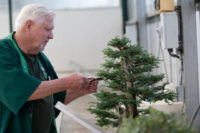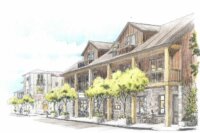When an errant truck bashed into a City Hall archway the damage turned out to be a chip off an old, rare block.
The pillar needs to be repaired, but finding the right materials has city officials between a rock and hard place. Since the August collision, they’ve had no luck finding a stone that closely matches the color, texture and workability of the blocks quarried in 1906 to frame the historic structure.
Staff and City Historian George McKale have attempted to find the original quarry location for the City Hall blocks, but the trail is cold as, well, stone. “I researched it, but couldn’t find any documents indicating where it was obtained,” McKale said.
The need is for two large matching stones that can be cut and trimmed to dimensions of approximately 16 by16 by 30 inches, according to the Development Services Director Wayne Wirick.
Wirick said the stone is thought to be a Sonoma volcanic tuff characterized by its fine texture, light grayish-tan coloring, its ability to be easily cut and trimmed and vesicular pin-holes located throughout the blocks.
“The stone certainly may have been obtained locally,” McKale said. “There are numerous quarries behind the City, and the density and color of basalt quarried in our hills is quite varied.”
The best bet, Wirick said, is the eastern hills of Sonoma Valley or in the Napa Valley.
Anyone with knowledge of the actual quarry location or that knows of available stone that closely matches the City Hall material, is encouraged to contact Wayne Wirick Jr. at Sonoma City Hall at 707-938-3681 or [email protected].
Though compromised, the column presents no immediate danger. After the collision, it appeared the solid pillar was only superficially damaged. But a closer inspection by engineers revealed fractures within its structure. “It has lost some capacity to bear the load,” Wirick said at the time.
There is also concern that the archway itself was damaged, but that can only be diagnosed after the stone column is removed. “We’ve got some investigative work to do,” Wirick said.




